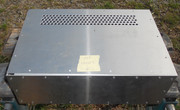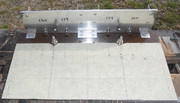Since I joined Groupdiy about 17 years ago, I have been making gear for other people, just for a change I decided to make a transistor amp for myself.
I don't like PCB's so this will be made as far as possible like I would make a tube amp. The circuit is by Mullard from around 1970.
First the box.

I have attached a generous heatsink to some bakelite board and it fits inside the box OK

I covered it with masking tape to measure carefully for the component holes.

The components will be soldered on the other side with wire.
I originally planned to make a hifi tube amp but this seemed quicker and a good way to explore a new technique.
Best
DaveP
I don't like PCB's so this will be made as far as possible like I would make a tube amp. The circuit is by Mullard from around 1970.
First the box.

I have attached a generous heatsink to some bakelite board and it fits inside the box OK

I covered it with masking tape to measure carefully for the component holes.

The components will be soldered on the other side with wire.
I originally planned to make a hifi tube amp but this seemed quicker and a good way to explore a new technique.
Best
DaveP






















![Electronics Soldering Iron Kit, [Upgraded] Soldering Iron 110V 90W LCD Digital Portable Soldering Kit 180-480℃(356-896℉), Welding Tool with ON/OFF Switch, Auto-sleep, Thermostatic Design](https://m.media-amazon.com/images/I/41gRDnlyfJS._SL500_.jpg)










